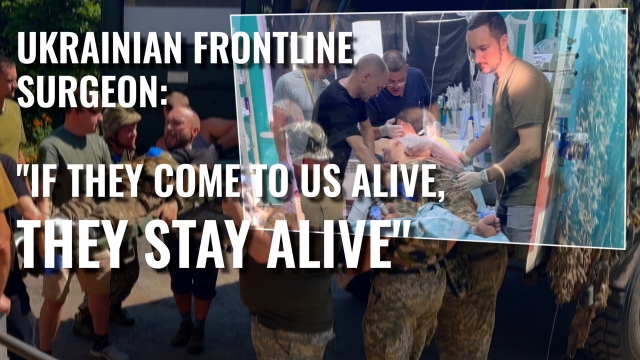The ambulance is packed with four wounded soldiers, all part of an infantry unit struck by Russian artillery while fighting in the counteroffensive.
Eight miles from the killing fields of southern Ukraine, there's the front line of war medicine — a village clinic, now the first stop for wounded warriors.
Scripps News was given rare access to this critical stop between rudimentary battlefield first aid and high-tech trauma hospitals.
The Ukrainians call this a "stabilization point." Each patient gets a number, a room and a team.
The head doctor rushes between them and assigns surgeons like Yasylyi Remenchits to treat the most critical cases. Everyone watches the clock.
SCRIPPS NEWS' JASON BELLINI: When someone arrives in an ambulance here, what's your goal? How quickly do you want to get them into another ambulance to the city?
YASYLYI REMENCHITS: 15-20 minutes. We must do quick and then receive him to the hospital.
In Remenchits's surgical suite, there's no running water. The most advanced imaging equipment is an ultrasound kit, donated by a charity abroad.
SEE MORE: Air defense team protects front-line soldiers from Russian drones
Nonetheless, Ukraine believes its stabilization point strategy may explain why, on their side — according to a leaked U.S. intelligence assessment — only 1 in 7 battlefield injuries leads to death. For the Russians, it's 1 in 5.
A new ambulance full of wounded can arrive at any time, typically with just 15 minutes' notice. Many of Ukraine's most risky counteroffensive operations happen at night.
The doctors, nurses and staff at the stabilization point don't just work there, they live there, many of them for weeks, if not months on end. They sleep on thin mattresses on the floor. At stabilization points, everyone is always on call.
Remenchits, who is 29, worked as a pediatric surgeon in Kyiv before Russia's full-scale invasion.
BELLINI: Is this a normal day?
REMENCHITS: Yeah, it's a normal day. And it is like easy day.
From that group of four who arrived together in one ambulance: A concussion, a broken leg, two shrapnel injuries — one hit in his neck, another, a 30-year-old named Volodymyr, hit in his thigh.
Just 30 minutes after they arrived, Volodymyr and his comrades are loaded into another ambulance for the hour-long drive over battle-scarred roads to the Zaporizhia trauma hospital. There's very little break before the next ambulance.
The capacity recently increased to 300 patients per day. Despite all the preparation for the main thrust of the counteroffensive, Remenchits remains nervous about how brutal and bloody it will most certainly be.
He and the other doctors will follow the front line and continue providing cover to Ukrainians fighters — fighting for their lives.
Trending stories at Scrippsnews.com




